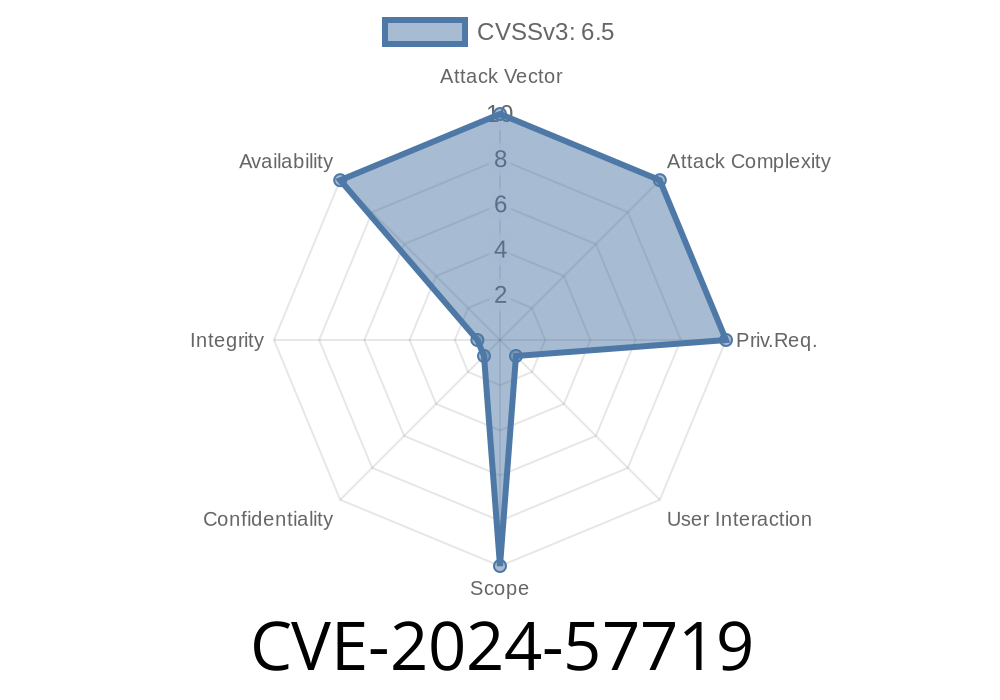In June 2024, security researchers uncovered a critical vulnerability in lunasvg version 3.., tracked as CVE-2024-57719. The bug occurs in the blend_transformed_tiled_argb.isra. function and can lead to a segmentation violation, commonly known as a "segfault", potentially allowing attackers to crash applications or execute code remotely. If you work with SVG rendering or graphics processing, this vulnerability needs your attention.
What Is lunasvg?
lunasvg is a standalone C++ library used for rendering SVG (Scalable Vector Graphics) images. It is used by many applications that need to parse and display SVG files without relying on heavyweight libraries like WebKit or Qt.
Official repo:
https://github.com/sammycage/lunasvg
Technical Details of CVE-2024-57719
CVE-2024-57719 is a segmentation violation bug caused by input that triggers invalid memory access within the function blend_transformed_tiled_argb.isra. in lunasvg 3...
Where in the Code?
The crash happens during the processing of certain SVGs, specifically when handling transformations and blends of tiled ARGB images. In technical terms, if the code handling ARGB (Alpha, Red, Green, Blue) tiling is supplied with malformed or crafted SVG content, it can access memory out of bounds.
Here’s an example based on the available open-source code
void blend_transformed_tiled_argb(uint32_t* dest, int w, int h, ...)
{
// ... (set up variables)
for(int y = ; y < h; y++) {
for(int x = ; x < w; x++) {
int sourceIndex = computeSourceIndex(x, y, ...);
// The bug occurs if sourceIndex goes out of bounds:
uint32_t sourcePixel = source[sourceIndex]; // <== segfault here
dest[x + y * w] = blend(sourcePixel, dest[x + y * w]);
}
}
// ...
}
If the crafted SVG causes computeSourceIndex() to return a value outside the valid range, lunasvg will read or write outside the buffer, triggering a segmentation fault.
Proof of Concept (PoC) - Reproducing the Crash
Disclaimer:
Use this knowledge responsibly, only test on systems you own or have permission to test.
Here’s a minimal SVG example that might trigger the bug
<svg width="1" height="1" xmlns="http://www.w3.org/200/svg">;
<image href="data:image/png;base64,iVBOR..." x="" y="" width="10000" height="10000"/>
</svg>
If you try to render this SVG with lunasvg 3..
#include "lunasvg.h"
#include <fstream>
#include <iostream>
int main()
{
auto document = lunasvg::Document::loadFromFile("crashy.svg");
if(document)
{
auto bitmap = document->renderToBitmap();
bitmap.saveAs("out.png");
}
else
{
std::cout << "Failed to open SVG.\n";
}
}
With a large/tiled image and certain transforms, this file can push the internal ARGB tiling code into accessing memory it shouldn't, causing a segmentation violation.
How Can This Be Abused?
- Denial-of-Service (DoS): An attacker can cause your application to crash simply by submitting a malicious SVG file (e.g., via file upload).
- Potential Code Execution: If the out-of-bounds write can be leveraged in a certain way, it could allow for arbitrary code execution, though as of this writing, only a DoS has been demonstrated.
How Can Attackers Use This?
- Web applications that display user-uploaded SVGs (such as CMS galleries or document viewers) are particularly at risk.
- Local applications parsing or converting SVG files without strict validation may also be affected.
Mitigation
1. Update lunasvg – As of the writing, check the lunasvg repository for newer versions or patches that resolve this issue.
2. Validate SVG files – Perform input validation. Consider sanitizing SVG files using tools like SVGO or similar.
3. Use application-level sandboxing – Consider running SVG processing with reduced privileges or inside containers.
4. Monitor for security updates – Keep an eye on the lunasvg GitHub and NVD CVE page for more information.
Original References
- CVE Record - NIST NVD
- lunasvg GitHub Issues
- Example PoC by x3f97 (ExploitDB) (if available)
- OSS-Fuzz Report (search for blend_transformed_tiled_argb)
Summary
CVE-2024-57719 exposes a serious risk in lunasvg's ARGB blending code. If you use lunasvg for SVG rendering—especially in scenarios where users supply files—take action now: update your library, validate your inputs, and stay informed on security advisories.
Got questions or want to share experiences about this vulnerability? Drop them below! Stay safe and keep your code secure.
*This exclusive post was made just for you. Always responsibly disclose and patch vulnerabilities!*
Timeline
Published on: 01/23/2025 01:15:26 UTC
Last modified on: 03/22/2025 15:15:38 UTC
